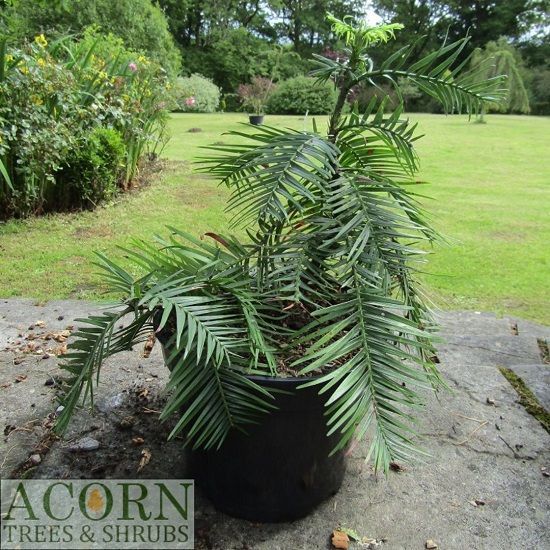Wollemia nobilis 5L 35-40cm EXACT ITEM OFFER
USDA H9, hardier when older, protect from frost until @3-4' tall. WE NEVER INCLUDE THE POT HEIGHT IN OUR QUOTED DIMENSIONS
Wollemia is a genus of in the monkey puzzle family Wollemia was known only through fossil records until the species Wollemia nobilis was discovered in 1994 in a temperate rainforest wilderness area of the Wollemi National park, NSW, Australia.
In both botanical and popular literature the tree has been almost universally referred to as the Wollemi pine, although it is not a true pine but, rather, is related to Agathis and araucaria. The oldest fossil of the Wollemi tree has been dated to 200 million years ago.
The Wollemi pine is classified as critically endangered on the IUCN list
Wollemia nobilis is an evergreen reaching 25–40 m (82–131 ft) tall. The bark is very distinctive, dark brown, and knobbly, quoted by some as resembling a popular breakfast cereal. The tree coppices readily, and most specimens are multiple-trunked or appear as clumps of trunks thought to derive from old coppice growth, with some consisting of up to 100 stems of differing sizes. The branching is unusual in that nearly all the side branches never have further branching. After a few years, each branch either terminates in a cone (either male or female) or ceases growth. After this, or when the cone becomes mature, the branch dies. New branches then arise from dormant buds on the main trunk. Rarely, a side branch will turn erect and develop into a secondary trunk, which then bears a new set of side branches.
The leaves are flat linear, 3–8 cm (1.2–3.1 in) long and 2–5 mm (0.079–0.197 in) broad. They are arranged spirally on the shoot but twisted at the base to appear in two or four flattened ranks. As the leaves mature, they develop from bright lime-green to a more yellowish-green.The seed cones are green, 6–12 cm (2.4–4.7 in) long and 5–10 cm (2.0–3.9 in) in diameter, and mature about 18–20 months after wund pollination. They disintegrate at maturity to release the seeds which are small and brown, thin and papery with a wing around the edge to aid wind-dispersal. The male pollen cones are slender conic, 5–11 cm (2.0–4.3 in) long and 1–2 cm (0.39–0.79 in) broad and reddish-brown in colour and are lower on the tree than the seed cones. Seedlings appear to be slow-growing and mature trees are extremely long-lived; some of the older individuals today are estimated to be between 500 and 1,000 years old.
Wollemia nobilis is the sole living member of its genus. These trees remained common throughout eastern Australia until around 40 million years ago but then gradually declined in range and abundance. Before the relict population was discovered.
Fewer than a hundred trees are known to be growing wild, in three localities not far apart. It is very difficult to count individuals, as most trees are multistemmed and may have a connected root system. Genetic testing has revealed that all the specimens are genetically indistinguishable, suggesting that the species has been through a genetic bottleneck in which its population became so low (possibly just one or two individuals) that all genetic variability was lost.


